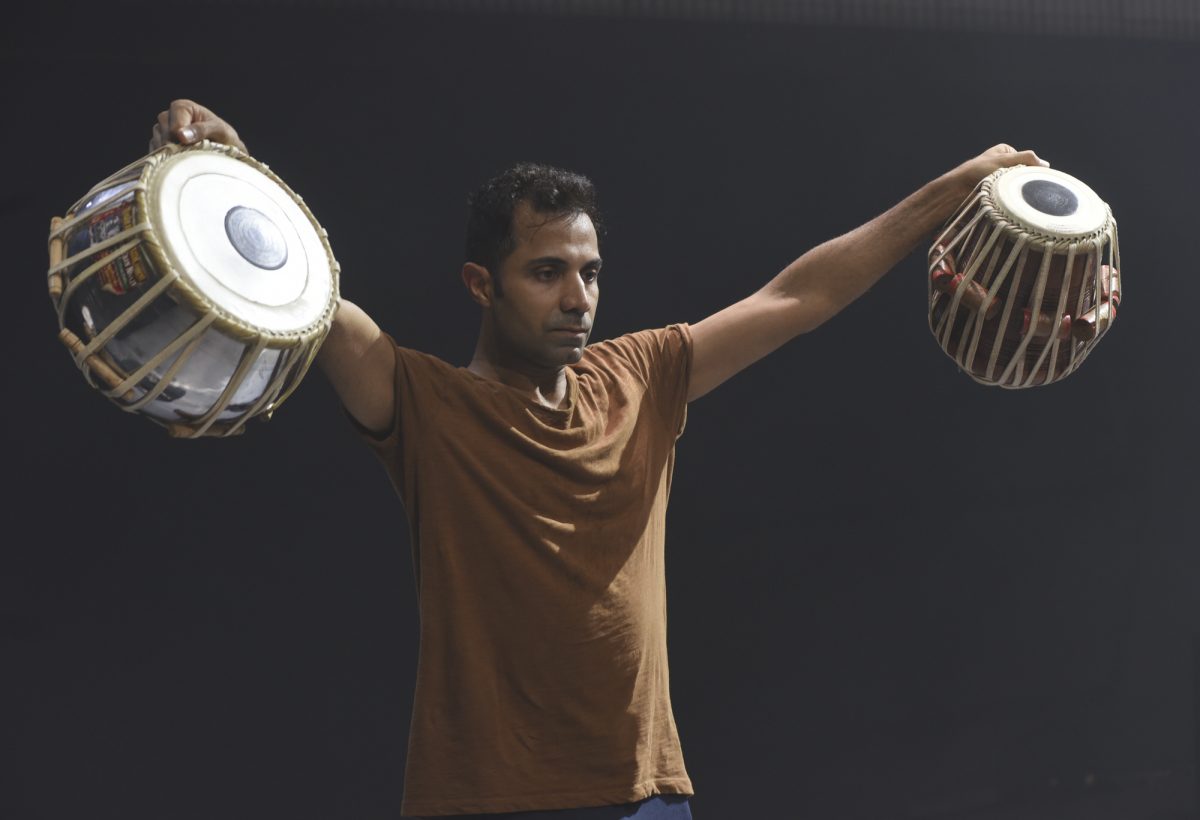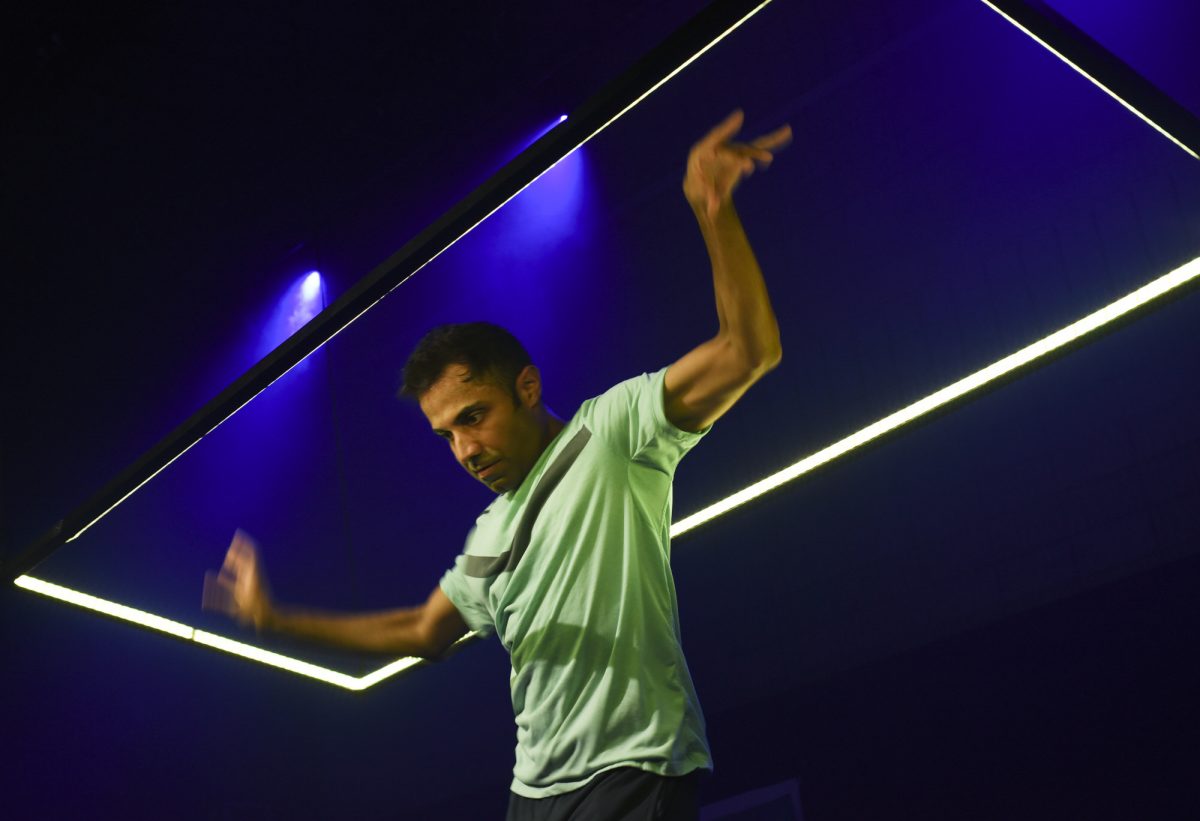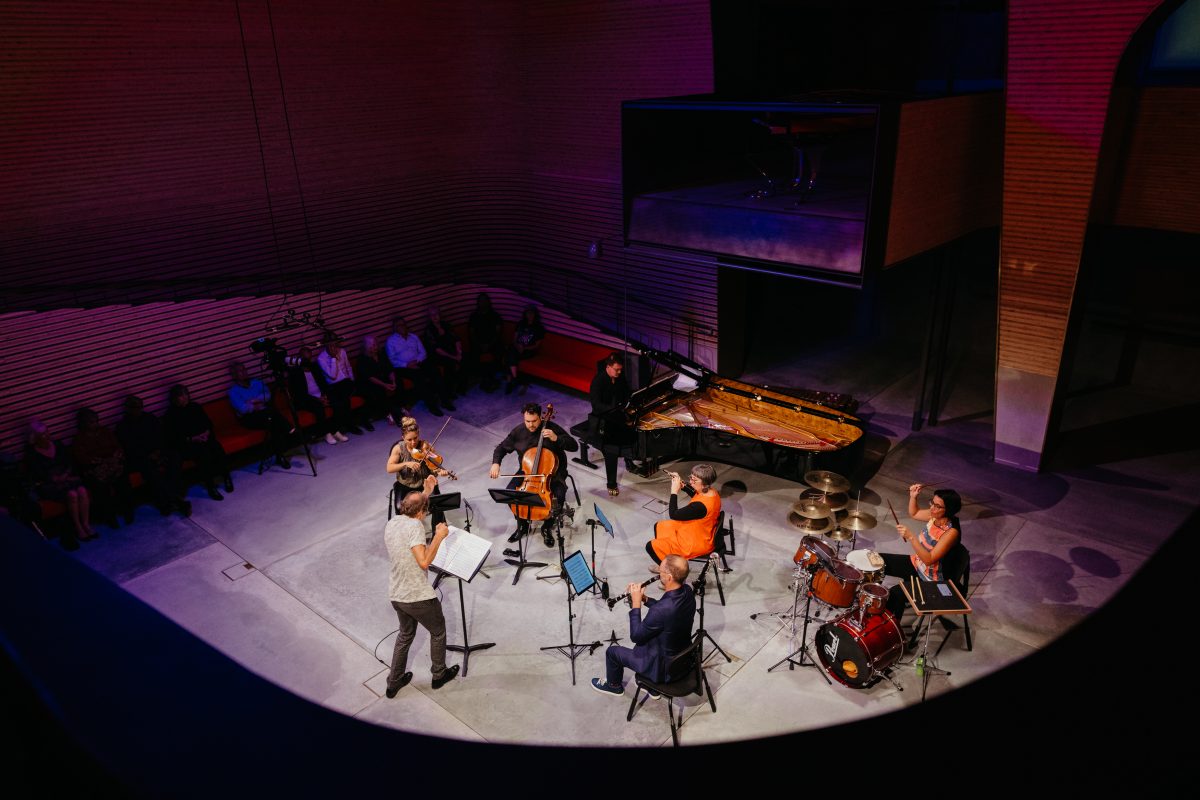February 2021
Raghav Handa takes the traditional Kathak dance recital, already informal in its improvisational interplay between dancer and musician, a bold step further, playing it out as a witty, intimate ‘real-life’ encounter shared with the audience. Handa warms up, tabla player Maharshi Raval arrives, there’s banter, some preliminary drumming on boxes and responsive moves from Handa. Then the pair shape the boxes into a platform for the tabla drums. The performance is palpably constructed as we watch, listen and learn.
Raval puts Handa through his paces — too fast at 12 beats, the dancer objects; will 6 do, asks the drummer with mock condescension. The artists are role playing humble dancer and master musician. Raval triggers the dance in the first instance, not just with the drumming but with the emphatic vocal delivery of the abstract but distinctively musical syllables (bol) that count out the meters (tala) that drive Kathak.
Ever elegant, Raghav Handa nonetheless can display the vibrancy of a puppy and the friskiness of a colt (in Sue Healey’s On View: Live Portrait series he moves in parallel with an onscreen trainer managing a lively horse), so it’s not surprising that when prompted by Raval’s tabla and bols, the dancer’s initial responses — head sliding side to side, limbs articulating acutely or, at one point, head and then body furiously quivering — give sudden way to explosive dancing about the stage, arms extended, high kicking, twirling, rolling, moving with astonishingly deft footwork in a circle that takes him back to his starting point, facing Raval, with a sense of breathless completion, ready for the next challenge. All the while he’s supported by the deep pulse, glides, quickfire tapping and bell-like harmonics of Raval’s virtuosic drumming.
A traditional Kathak dancer might not move far, if at all, from their initial standing position, often working up and out from patterned movement of the feet (ankles ringed with bells that make their own musical statement). Handa only briefly engages with this stage each time before taking flight; too briefly perhaps. I wanted more of this precision. However, Handa is not constrained by tradition; his engagement with Western dance is revealed in the artful looseness of his liberated moves. Even in these, my untutored eye detected traditional shaping, not least in the final circling on opening night when, just as I’d been feeling that a sameness was becoming evident in these improvised eruptions, Handa, with arms extended, right-angling up at the elbows, span with sublime elegance back to Raval.
In a game of gentle subversion, Raghav Handa tests the ordained boundaries between musician and dancer. The dancer must not touch the drums, but when Raval exits (to move his car!), Handa is tempted, a tiny gesture yielding punishment from an instantly suspicious Raval on return. Beginning with Handa straining to hold high a small but weighty drum in each hand, casual retribution becomes boundary crossing art with the dancer stretched out on the floor, the drum beaten by Raval against chest and then stomach.
In turn, Handa draws Raval into his dancing, the pair making an admirable duo until the sinuously able musician dismissively dips out. As jobbing artists (Raval asks Siri for his next gig), the pair have a history of collaboration, including performing at corporate events for which they needed a banner. As they unfold and hoist the outcome, Handa tells of commissioning it from a famed Indian graphic artist notable for his Bollywood poster work. The artist is nonplussed — who’s the hero, who’s the villain? The result: a kind of sexy idealisation of the pair, revealed with droll self-deprecation.
The staging, true to Kathak tradition, is simple, an open space, but with the addition of three rectangular shapes, all becoming mobile: the musician’s platform, the promotional banner and a metal frame suspended over the stage. These come into play with the raising of the banner, and with Handa slowly pushing the platform, Raval playing, across the stage (from its traditional position, on the audience’s left), yielding fascinatingly hued colour rectangles projected across the floor. Both artists engage with the internally lit metal frame which literally reframes them in a surreal Bollywood cum disco modernity, requiring of Handa great upper-body dexterity as the device swings and sways with sometimes threatening speed.
Raghav Handa dances within and beyond constraining frames. Working from within Kathak, he can extend, depart from and fluently return to it, respectfully obeying the principles embodied in Maharshi Raval’s pervasive commitment to the form’s fundamental rhythms. That respect neatly shapes the structure of the performance.
I greatly enjoyed the performers’ wry, relaxed intimacy (doubtless encouraged by dramaturg Julie-Anne Long), a reminder that the etymology of Kathak includes ‘conversation’ and ‘story’ — in this case of a creative relationship. The great Kathak dancer Akram Khan, like Handa both traditionalist and moderniser, has said, “If you don’t understand the music you don’t understand the dance.” TWO took me a little way towards that understanding, for which I’m grateful. Not least, integrated design (Justine Shih Pearson) and lighting (Karen Norris) cumulatively transformed the initially spare stage into a vividly complex, mutating space reflecting creator Raghav Handa’s benignly subversive vision.
TWO’s clever framing of the complexities and joys of modern Kathak within an amiable, everyday conversation between artist friends makes for vitally engaging theatre warranting a large audience (variable audibility though needs to be addressed). TWO is also another fascinating addition to Raghav Handa’s impressive body of work.
See RealTime reviews of Raghav Handa’s Men’s rea: The Shifter’s Intent and Tukre.
—
Form Dance Projects and Riverside Theatres, TWO, creator, choreographer, performer Raghav Handa, tabla player, performer Maharshi Raval, design Justine Shih Pearson, lighting design Karen Norris, dramaturg Julie-Anne Long, LED frame construction Alejandro Rymer, producer Performing Lines; Lennox Theatre, Riverside Theatres, Parramatta, Feb 18-20
Top image credit: Maharshi Raval, Raghav Handa, TWO, photo Heidrun Löhr
The launch of a bracingly addictive new album from Ensemble Offspring — Offspring Bites 3: En Masse — provides an occasion for reflection in a forthcoming RT edition on our responses over several decades in the RealTime archive to this ever-inventive Sydney-based contemporary music group. Here’s my take on the album after a couple of first listens.
En Masse [32 minutes], Alex Pozniak’s gripping sonic essay on weight and on ensemble-as-mass, almost but never quite transforms into a march; its stormy, thumping piano and drum-kit-driven fits and starts trigger resonant turbulence in the lightning flights of strings and winds that are inevitably earthed in the 30-minute work’s dramatic sense of accelerating entropy, save for moments, especially in the middle movement, when an eerily beautiful near inertia takes seductive hold.
In contrast, Holly Harrison’s bend/boogie/break [10’] revels in regular beats, an invitation to savour the composer’s witty take on instrumental and subtle structural distortions in music’s time-space continuum. It’s variously moody, funky, cartoony, almost a tango, and powers to a finish cut short with final notes slowly warping in descending glissandi, emptying into the void — victims of Pozniakian mass?
Counterpointing the rhythmic energies of Harrison and Pozniak, Thomas Meadowcroft’s Medieval Rococo [13’] commits at length to a reverberant contemplative pattern, its delicate acoustic textures becoming densely layered with soaring electronics. These depart but soon return along with a driving dance beat. It drops out briefly — as sounds acoustic and digital swirl, magically enmeshed — but then pulses on to the end, undaunted by gravity. Perhaps. We know the end story of expanding universes. (As for the title, the composer writes, “‘Medieval’ denotes music crude and backward, ‘rococo’ denotes music garish and arty.” This essentially serene composition seems neither descriptive, ironic or satirical, though ‘arty’ might fit, in the nicest way. Perhaps I’d left my ‘good taste’ sensor unplugged.)
As mutually rich explorations of music making that rewardingly expand and deepen the listening experience, these three works make great companion pieces. As ever, they are superbly played and recorded by Ensemble Offspring. A recorded live performance of Pozniak’s En Masse and video artist responses to bend/boogie/break and Medieval Rococo are available online, making for all-round immersive engagement.
—
Ensemble Offspring, album En Masse, Offspring Bites 3, performers Claire Edwardes (percussion), Jason Noble (clarinets), Lamorna Nightingale (flutes), Véronique Serret (violin), Blair Harris & Rowena McNeish (cello), Benjamin Kopp & Zubin Kanga (piano) Roland Peelman (conductor, Pozniak’s En Masse).
Album available here.
Top image credit: CD cover, Offspring Bites 3: En Masse, photo & design Dale Harrison






